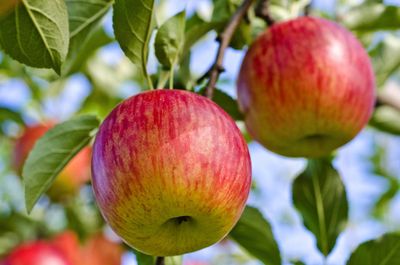Fuji Apple Information
Fresh, crunchy, sweet/tart apples are one of life’s simple pleasures. Fuji apple trees produce perfectly balanced fruits that remain fresh tasting for a long time. Fujis are warm climate apples but are considered hardy down to USDA zone 4 and up to 8. Some tips on how to grow Fujis will have you picking these sugary fruits right from your backyard tree. Fuji apple trees grow 15 to 20 feet wide with the same spread (4.5-6 m.). The fruits contain 10 to 18 percent sugar and are excellent for eating right off the tree, in pies, or sauce. Flowers consist of pretty creamy white to pink blooms. The apples are round, medium to large with yellowish green skin often blushed with pink or red. Occasionally, the skin will be attractively striped. Amazingly, the fruits can keep for up to a year if refrigerated properly. Fuji apple trees, like most apples, need a pollinating partner. Gala, Jonathan, Golden Delicious, or Granny Smith are good suggestions.
How to Grow Fujis
Fuji apples need to be sited in a location where they will receive 200 to 400 chill hours to flower and fruit. This is considered a “low chill” apple, since many varieties need many more chill hours and are only suitable for cold, northern climates. Select a location with full sun for best production. Soil should be well draining, nutrient rich loam. Plant trees while still dormant in the cool season but when hard freezes are not expected. Young trees may need a stake initially to keep them growing straight as well as some training to develop an open vase-like shape with sturdy scaffold branches. Keep young trees well watered.
Fuji Apple Tree Care
Once established, growing Fuji apples is a breeze. Thin the apple trees annually to prevent crowding of fruit. Prune when dormant and remove any vertical branches, crossed limbs, broken, or diseased wood. After ten years, remove some of the fruiting spurs to make room for new producing material. Spread mulch around the base of the tree at the root zone to conserve moisture, limit weeds, and gradually feed the tree as the mulch decomposes. Fuji apples are susceptible to fire blight, apple scab, cedar apple rust, and powdery mildew. Apply copper-based fungicides in spring. You can expect ripe fruit around mid-October. Store them gently in cool temperatures or refrigerate what you can’t gobble up immediately.
